Estimated reading time: 12 minutes
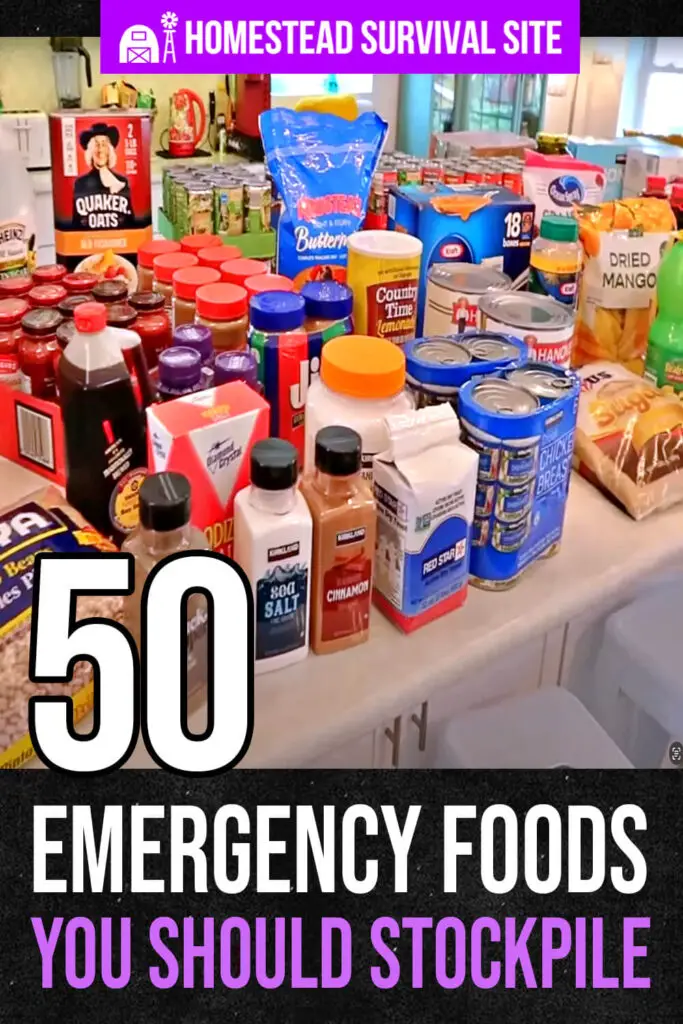
Modern life has led people away from their backyard gardens and well-stocked root cellars. These once farmhouse staples helped ensure that families could feed themselves no matter how long the road to town was, what the weather was like, or their economic situation.
While access to grocery stores makes it seem like there’s no need to worry about keeping food on the table, there are many potential emergencies that could happen: losing your job, blizzards, or even economic collapse.
These things could leave your family without a secure food source. Even if you don’t live in a farmhouse, it’s easy and wise to stockpile emergency foods.
Below you'll find a list of 50 emergency foods you should be stockpiling. With all of these foods on hand, you'll be eating well no matter what happens.
1. Baking Powder
Another leavening agent, baking powder is an important part of many recipes. It’s also cheap and easy to store.
2. Baking Soda
It’s cheap and absolutely worth stocking up on. It’s an important leavening agent in many recipes and can be combined with a little vinegar and used in place of eggs in quick breads and cake recipes. It also makes a good, natural cleaner and deodorizer. It's just over a dollar a pound.
3. Beans
While they take quite a bit of time to cook, they’re easy to store, very cheap, and full of protein. Another consideration is that in a long term survival situation, they can easily be planted to replenish food stores.
4. Bouillon Cubes
While not as nutritionally dense as bone broth, bouillon may still be worth storing. For little cost and space, it adds a lot of flavor to meals. It can be tossed in with rice, used to make gravy or sauce, or even cooked with instant potatoes. Be sure to get chicken and beef cubes.
5. Canned Beans
Canned beans are a fantastic source of protein and fiber. They're versatile and can be added to a variety of dishes or eaten straight from the can if necessary. Plus, they don't require any cooking or water like their dried counterparts.
6. Canned Chili
Canned chili is an excellent source of protein and fiber, and it's ready-to-eat right out of the can. It can be a meal on its own or used as a topping on rice or pasta.
7. Canned Fruits & Vegetables
They’re full of important vitamins and will last for extended time periods. They also usually have quite a bit of liquid as another small source of clean water to keep you hydrated. Tomatoes are especially important, either diced or whole, as they can be used to make a variety of meals, condiments, and sauces.
8. Canned Meat/Fish (chicken, turkey, tuna, salmon)
Canned meat and fish are convenient and require no cooking or extra water. They can be added to any meal or eaten as is.
9. Canned or Boxed Broth
Having a supply of canned or boxed broth can provide a base for soups, stews, or even just a warm, comforting drink. It's also a great way to add flavor to rice or pasta.
10. Canned or Jarred Fruits
While dehydrated fruits are great, canned or jarred fruits can also be a valuable addition to your emergency food stash. They typically retain their taste better than dried fruits and also provide a good amount of liquid.
11. Canned Soups and Stews
These are ready-to-eat, nutrient-dense, and offer a variety of flavors to keep your meals interesting. They also provide a valuable source of hydration. Just make sure to choose low-sodium options when available to manage your salt intake.
12. Canned Vegetables
Canned vegetables, such as green beans, peas, carrots, and corn, provide essential nutrients and add variety to meals. They can be eaten as is, or used in cooking.
13. Cereal
Many families are accustomed to eating cereals, but they’re also important because they’re fortified. Most cereals contain a large part of your daily vitamin requirements.
14. Coffee
Many people would have a hard time giving up their morning coffee, even in an emergency situation. Having at least some coffee on hand can make a rough time a little bit easier.
Coffee grounds can then be re-used in the garden or to scrub things for cleaning. You can even put them in homemade soap for a built-in scrubber.
15. Crackers
Crackers can help create a sense of normalcy in a survival situation. They are also great for stretching meals. Things like soup are much more filling with a handful of crackers.
16. Dehydrated Fruit
Store-bought dried fruit can be quite expensive, but it’s easy to make at home. Simply cut up your fruit of choice into fairly small pieces and place them in a dehydrator.
You can also experiment with fruit leathers. All you need is fruit puree spread in a thin layer on a dehydrator tray. Great combinations include applesauce and blackberries, strawberries and bananas, and peaches and raspberries.
17. Dehydrated Milk
It may not be as tasty as fresh milk, but dehydrated milk can add essential fats and proteins to your diet in a survival situation. It’s also important for many recipes that just wouldn’t be the same with water, plus it lasts a long time.
18. Dehydrated Vegetables
While canned vegetables certainly have their place, dehydrated vegetables are often an awesome choice because they’re lightweight and take up much less space. Corn, sweet peppers, and tomatoes are all good options. Just like with fruit, these will be cheaper to make at home.
19. Dried Bone Broth (aka portable soup)
It may sound weird, but people have been making this portable soup for centuries. It was a favorite among woodsmen, travelers, soldiers, and even housewives. It’s super convenient, but unlike modern bouillon, it’s incredibly nutrient-dense and easy to make at home.
20. Dried Flint/Dent Corn
Flint or dent corn are varieties that are grown to be dried, ground, and used as a grain not sweet corn. They last virtually forever and are easy to grind to make cornbread, tortillas, grits, etc. Plus you can plant some to grow more as needed.
21. Dried Meat/Pemmican
Canned meat and fish are healthy and tasty, but they’re much heavier and bulkier than their dried or smoked counterparts. Consider adding beef jerky or pemmican to your home food storage at the bare minimum. Both are shelf-stable and easy to make at home.
22. Dried Soup Mixes
Dried soup mixes can be a lifesaver when you need a quick, easy meal. They're lightweight, easy to store, and just require boiling water. Plus, they come in a variety of flavors to keep meals interesting.
23. Dry Yeast
It may be advisable to store both bread yeast as well as yeast for brewing beer or wine. Even if you have these on hand, it’s also important to learn how to make sourdough or wild yeast starters so that you could make your own bread even if your supply ran out.
24. Flour/Wheat Berries
Obviously, flour is a staple of the modern diet, but there are a few things to consider before running out and buying big bags of it. First, whole wheat flour doesn’t store well. The oils have been released from the wheat berries and it can go rancid quickly. Second white flour offers little nutritional value.
For these reasons, the best option may be to purchase whole wheat berries which store well while retaining their nutrition, especially those in #10 cans. Whole wheat berries can be easily turned into flour with a hand crank mill, they can be cooked whole as hot cereal, or they can be added to soups and stews. Wheat berries can also be planted.
25. Granola Bars
Granola bars are another ready-to-eat snack that can provide a quick energy boost. Look for ones high in fiber and protein and low in added sugars.
26. Honey
Honey is more than just a tasty treat! It’s natural preservative, immune system booster, antibacterial, and anti fungal. Make sure you get real honey and not the fake stuff.
27. Instant Noodles
Instant noodles are a quick and easy meal that only requires boiling water. While not the most nutritious option, they are filling, and you can enhance their nutritional value by adding canned vegetables or meats.
28. Instant Potatoes
Instant potatoes offer a lot of benefits for little cost. They’re filling, cheap, last practically forever, and are lightweight and small in storage. They also only require boiling water, so you won’t use much fuel making them.
29. Lentils
While often overlooked, lentils are an excellent, versatile source of protein. They’re also light and cook much faster than beans.
30. Nuts
Storing nuts and/or trail mix can be an excellent choice for a quick, protein-packed snack without the need to cook.
31. Oatmeal
Oats are another great option for stretching other foods. For example, they can be mixed with meat or beans to make burgers or tossed in bread recipes. Obviously, they also make a great hearty, cold-weather breakfast combined with some dried fruit and nuts or seeds.
32. Pasta
While you can always make your own pasta, having some on hand is convenient in an emergency. It offers a quick and filling meal, plus it's fairly lightweight and easy to store.
33. Pasta Sauce
Pasta sauce and a box of pasta are one of the quickest, easiest meals to make in an emergency. It can also be used in a variety of other meals.
34. Peanut Butter (or other nut butter)
Especially if you have kids, peanut butter can offer a sense of normalcy and quick protein. Note that the dehydrated peanut butters on the market are nice and light but offer less fat than traditional peanut butter. If you have a grinder, you could also store peanuts and process them as needed.
35. Popcorn
Plain popping kernels are easy to store and great for keeping spirits high. For the amount of space they take up, they offer a lot of snacks.
36. Powdered Drink Mixes
Not only can powdered drink mixes, like lemonade or iced tea, help to make sure you stay hydrated, they can also provide a morale boost by adding some variety and flavor to your beverage options. Plus, they're lightweight and easy to store.
37. Powdered Eggs
Powdered eggs can be reconstituted with water and used in recipes just like fresh eggs. They're an excellent source of protein and can be used for everything from breakfast dishes to baking.
38. Protein Bars
Protein bars are an excellent ready-to-eat source of energy. They come in a variety of flavors and are easy to store. They're perfect for a quick meal replacement or snack in an emergency.
39. Protein Powder
Protein powder is a versatile and space-efficient source of protein. It can be mixed with water or milk (including powdered milk) for a protein shake, or incorporated into a variety of recipes to boost their protein content. It's a handy supplement to have, especially in situations where other sources of protein might be limited.
40. Quinoa
This nutrient-dense grain is high in protein and fiber, and it's a great source of many essential vitamins and minerals. Quinoa also cooks quickly and is very filling, making it a great staple to have on hand.
41. Rendered Lard
Modern recommendations are to freeze lard, but not that long in the past it was commonly just kept in canning jars or crocks and even used to preserve meat. If you’re making lard at home, make sure you render it, removing all the perishable parts.
42. Rice
It’s great for filling side dishes or as the base for a simple meal. When stocking up on rice, consider that while brown rice is much more nutritious, its shelf life is much shorter–about a year. This is because white rice has been processed to remove much of the natural oils and proteins found in brown rice.
43. Salt
Salt is so much more than a seasoning. In a survival situation it is essential to preserving food. It can be used to salt meats and pickle or can garden produce.
44. Seasonings
Seasonings are important to both everyday meals and food preservation. Everyone will be sick and tired of the food stores very quickly if there’s no seasonings for different meals. Keep what your family loves and regularly uses on hand, plus ones for canning, like pickling spices.
45. Seeds (pumpkin, flax, chia, sunflower)
Many seeds offer tons of nutrition and are light, easily stored, and tasty with a little salt or seasoning. Chia and flax seeds are notable for their Omega-3s.
46. Sugar
This is another essential preservative. With sugar, it’s easy to put up fruit and jam for winter.
47. Tea
Even if you don’t typically drink tea, it’s a good idea to store some. Tea takes up very little space and offers a flavorful caffeine boost. Plus, tea is antibacterial and can be used to clean small cuts. Herbal teas are also a good idea for their many medicinal uses. I really like this black tea.
48. Textured Vegetable Protein
TVP is sometimes thought of as being just for vegetarians, but in an emergency, it’s great to have around. TVP is full of protein, super lightweight, and has almost no flavor.
49. Vegetable Oil (olive, coconut, etc.)
Vegetable oil can add important fats to a survival diet and is important for many dressings and sauces. It’s also great for many herbal preparations and soaps.
Oil doesn’t last forever so it’s a good idea to rotate your stock or at least regularly check and make sure your oils haven’t gone rancid. I'm a big fan of Nature's Way Coconut Oil.
It can easily be seasoned on its own or mixed with a traditional dish to stretch more valuable foods. If you can't find it at the store, you can find it on Amazon.
50. Vitamin and Mineral Supplements
While not a food per se, stocking up on essential vitamin and mineral supplements can help ensure you're meeting your nutritional needs, especially in a long-term emergency situation where your diet might lack variety.
Final Thoughts
These basic pantry staples are truly valuable emergency foods. No matter where you live or what your situation is, it’s important to be prepared for disaster. Keeping nutrient-dense foods on hand can help keep your family healthy and happy no matter what’s going on in the world around you.
You May Also Like:

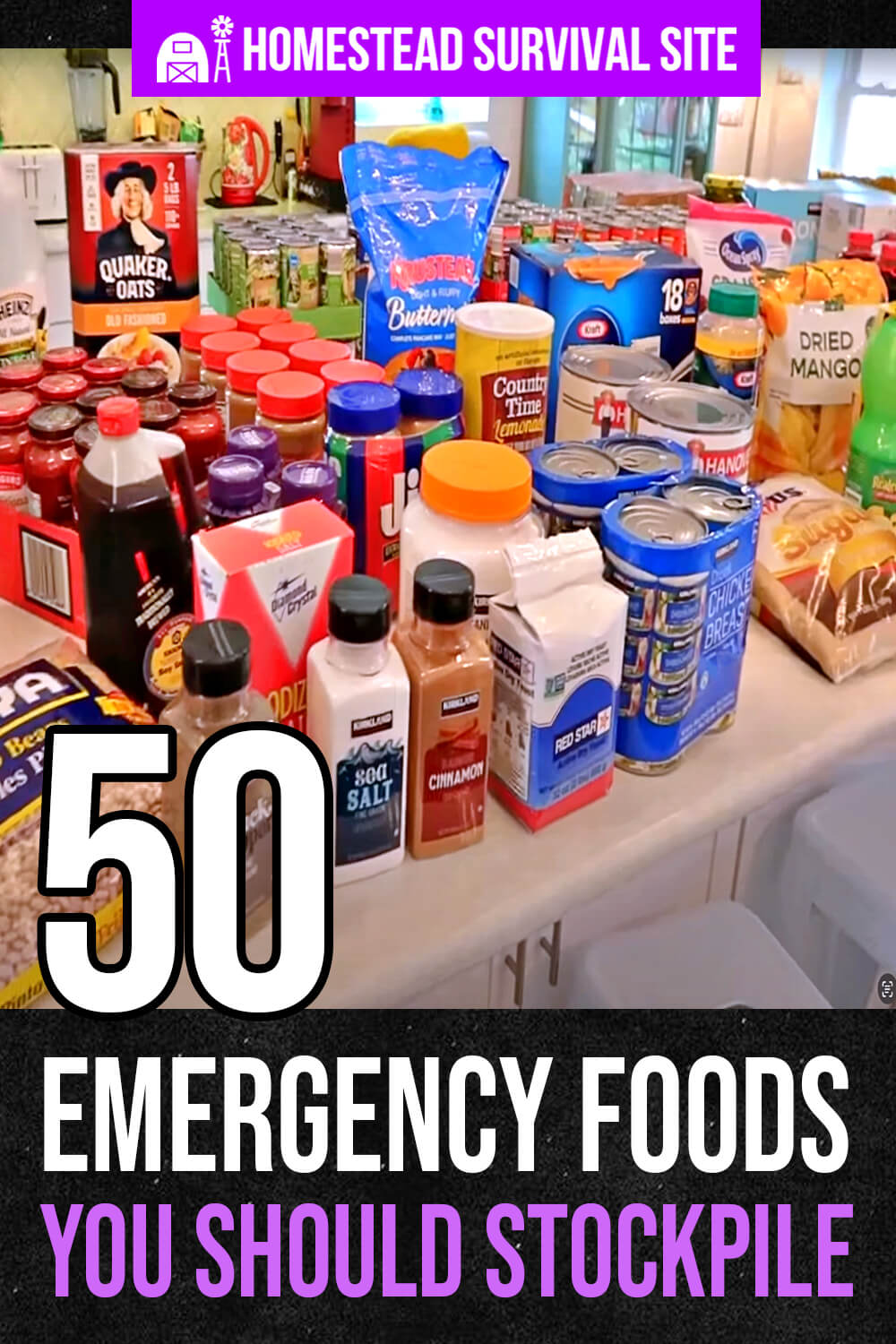



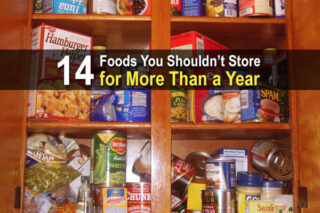
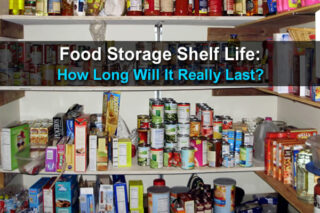

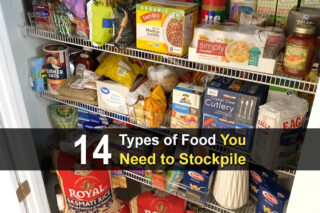
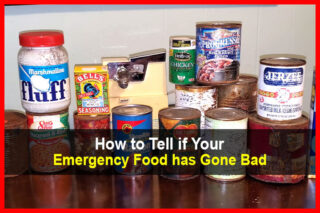



Hi
I stumbled onto your site looking for info on Uses for Borax I just scanned the fb page and was pleasantly surprised with the information on survival measures
Chris
I believe you can make washing powder or dishwasher powder with Borax. I’ve always found it difficult to get in the UK. Washing soda crystals are a good alternative.
Good advice for many people.
Such a great list of items! Thank you for sharing!
I’ve found crackers and probably most cereals only have a shelf life of six months and maybe up to 18 months.After that they turn really bad due to the chemicals in them. Try a test box and you will soon see.
I store saltine crackers in vacuum mylar bags. I recently opened a bag and they were just as good as the day I packed them and that was over 5 years ago. Vacuum and mylar are indispensable for long term storage. If you don’t have a vacuum sealer at least use oxygen absorbers and I recommend doubling up on them. You can find mylar that works with the Foodsaver vacuum sealer on Amazon and other places. Just google Foodsaver Mylar Bags.
Crackers are easy to make.
A word of caution to people in the warm south when storing dried things such as the stuffing mix pictured, rice, flour, etc. These can get bugs if they are stored for long periods of time. It is important to cycle this type of item so it does not remain in storage too long. You certainly don’t want to open a box in an emergency and find it crawling with tiny bugs!!!
Yes I am from the south and I know a lot of these items will not store here,not for long!
IF!!! you can, store wheat instead of flour. Buy the electric Wonder Mill(about 200 bucks) Flour has the wheat germ crunched up in it which holds oil. When released in the flour it goes rancid in about 1 to 2 years. Unground wheat lasts for centuries. Whenever possible store your rice and grains in a strong sealable container with oxygen absorbers. Lasts for years.
Take dry ice, open container, insert dry ice and close This will kill bacteria and preserve!
I either use canning, mylar with o2 eaters, or food vac grains, oats, pasta, beans, flour, etc. Prior to processing any of these, I place them in out upright freezer. As I understand it, this is a great way to kill off all the bug eggs.
Or, stash some bay leaves in the containers to keep bugs out. Good luck and happy prepping.
Although I can tell that a man made this list (!) most of the items are great for storage. Thanks.
Not sure why you would think that. It was made by a woman.
I’d wager that the lady who compiled this list would not be pleased with your attempt at stereo typing and obvious opinion that men are somehow inferior when it comes to being prepared. You must be a follower of Gloria Steinem and the radical left.
What you just said is stereotyping or jumping to conclusions. The authors name is Jordan ( either sex).
You do not know how she? Or he would feel?
If you have something constructive to add…do so.
The person who you commented to may have not meant it the way it sounded.
We should all try to support one another…
Hi,
Good list…I stock most. But I am curious about baking soda and vinegar to replace eggs. Have you ever tried it in baked goods? And what are the ratios? For the coronavirus stash, I’ve decided freezing eggs to make baked goods would probably be sufficient. Dried eggs are expensive.
Thanks,
Linda
I bake gluten free and vegan items all the time and using vinegar and baking soda to replace eggs works very well. Also a little vinegar in soy milk (only soy) makes amazing egg replacer. Soy milk comes on boxes that last for flippin’ ever. Win-win.
they are on sale some times on wall mart.com .I use them alot
Linda:
If you want to make a cake there are recipes out there called 2 ingredient cakes that use ginger ale or sprite and a cake mix.
Check out the cake mixes anymore they are bioengineered ugh along with many other foods we buy including candy. icing. breads. buns and the list goes on and on.
Baking soda and vinegar…what portions?
Would like to try.
How to use it in place of eggs: 1 teaspoon (7 grams) baking soda mixed with 1 tablespoon vinegar can take the place of one egg.
If your crackers or chips get stale, put them in the oven at 250 * for 15-20 minutes . They will be like new.
Only if you have power to run your oven. In a SHTF situation your power will probably be history!
Solar oven, make your own. If my grandmother could do it, you can. Mine can get up to 350F on a sunny day if I keep it positioned correctly.
I would love to see instructions for making a solar oven! Please tell how, or post link to instructions.
I’ll just use my wood cookstoves. I have 2 one that was probably used in a apartment in the day and a big one that I have well used.
I don’t refrigerate my lard. I never have and in 70 years no one has become ill from it. That was the way I was taught by my husbands grandmother.
Looks so much like my shopping list just prior to the pandemic shutdown.. Don’t forget the toilet paper!
Sandra, Speaking of TP: That was the one thing I didn’t have to worry about! I had changed to “Family Cloth” B4 COVID happened. I just took a packet [or 2] of Walmart facecloths, cut them in half, hemmed them and I was all set. I have to use one of those “toileting aids” since the pain in my back won’t let me bend that far. And the family cloth works with them too.
You can also pick up “bidet bottles” fairly cheap, same concept without the plumbing, fear of leaks and surely for emergencies/SHTF! I have a few extras on hand and offered to two people and they turned their noses up at the thought of rinsing clean (???).
SMH, I don’t get it
TVP comes in many varieties, some plain and some seasoned. It comes in chunks, pieces and ground forms. FakeMeats.com carries a good selection of the varieties it comes in. If you just buy plain, you should also stock some beef/chicken/etc. broths and some Kitchen Bouquet (a little makes it dark brown like cooked beef).
If you buy lard; be sure to buy ORGANIC lard { Available at Walmart) . It does not have bleaching agents;;preservatives or trans fats. It’s like the lard people used 190 years ago
Some of the things on this list need recipes!! Like pemmican! Also, links to where you can find things like dent corn.
Also, regarding popcorn, you can grind it for cornmeal.
Experience Luxury Living in a Balinese Villa
I love these list of all these great facts etc. But just in case I can’t access it I would love to see just a print this version button so I can print to have them for the future. Ok thanks for all the great info. Happy New year and God bless..
Popcorn!! Not just a snack but also you can grind the kernels in your grain grinder for cornmeal!
For the commenters asking for recipes – I find Pinterest a great resource for recipes.
I have also created a binder with a ton of information I have found and believe would be invaluable in an emergency situation. I have a section on recipes to utilize my long-term storage as well as my shorter term (aka rotational) storage.
How about storing grains etc in vaccum mason jars ? Will they last longer.
Air seems to be the enemy. I just bought a portable mason jar sealer
Works great